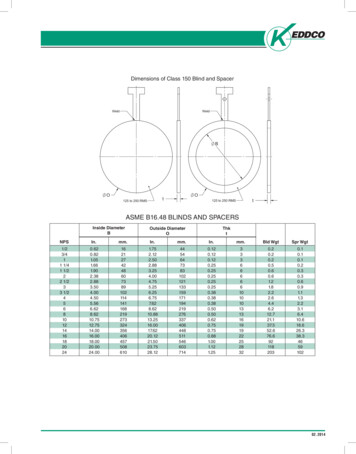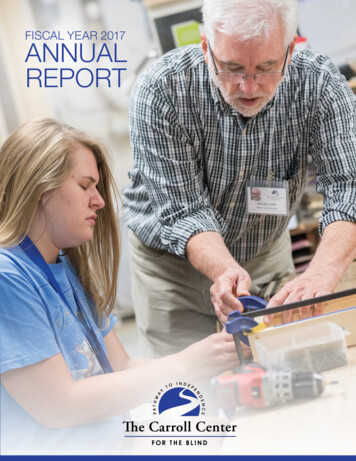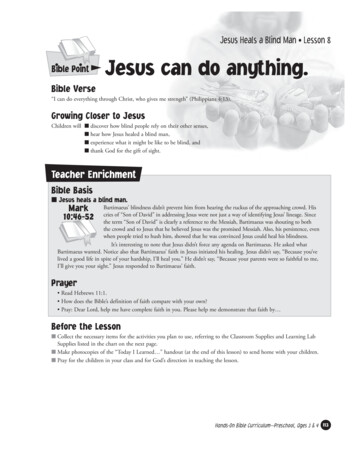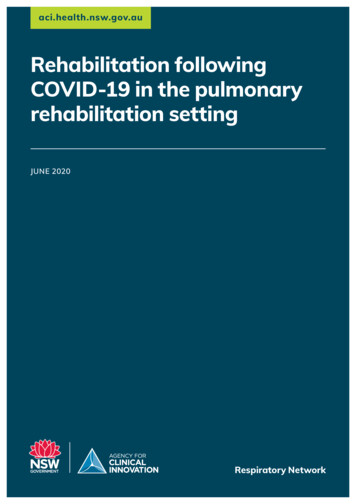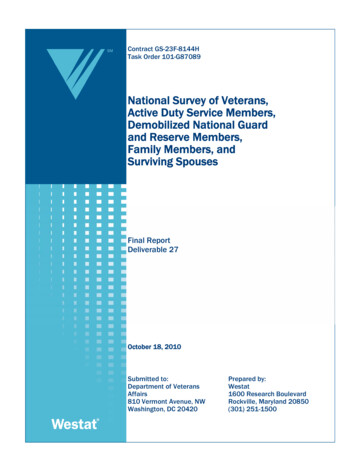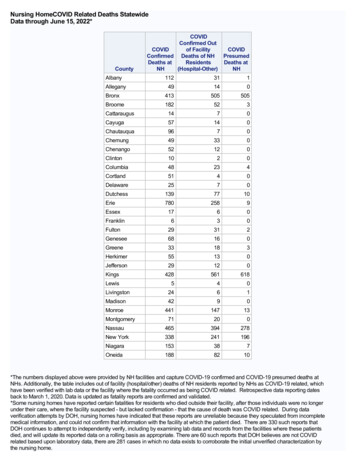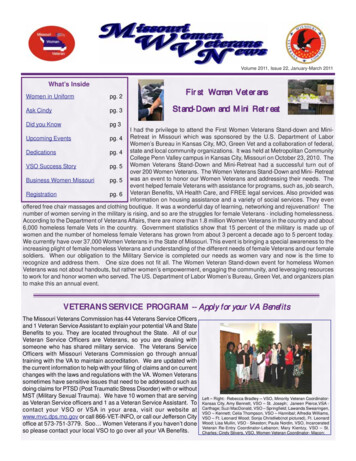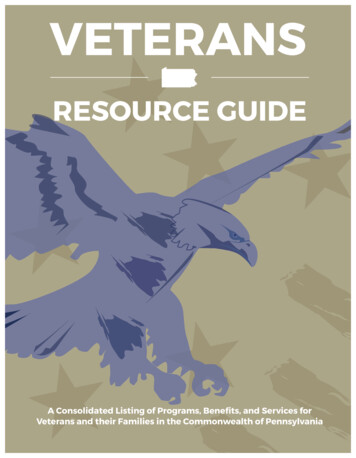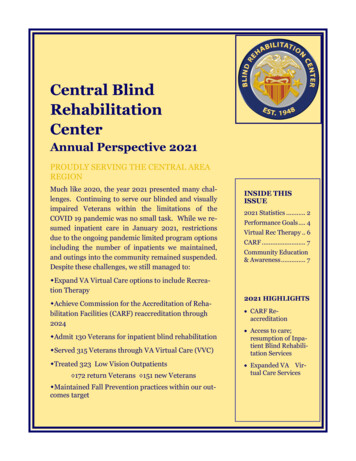
Transcription
Central BlindRehabilitationCenterAnnual Perspective 2021PROUDLY SERVING THE CENTRAL AREAREGIONMuch like 2020, the year 2021 presented many challenges. Continuing to serve our blinded and visuallyimpaired Veterans within the limitations of theCOVID 19 pandemic was no small task. While we resumed inpatient care in January 2021, restrictionsdue to the ongoing pandemic limited program optionsincluding the number of inpatients we maintained,and outings into the community remained suspended.Despite these challenges, we still managed to:INSIDE THISISSUE2021 Statistics . 2Performance Goals . 4Virtual Rec Therapy . 6CARF . 7Community Education& Awareness . 7 Expand VA Virtual Care options to include Recreation Therapy Achieve Commission for the Accreditation of Rehabilitation Facilities (CARF) reaccreditation through2024 Admit 130 Veterans for inpatient blind rehabilitation Served 315 Veterans through VA Virtual Care (VVC) Treated 323 Low Vision Outpatients 172 return Veterans 151 new Veterans Maintained Fall Prevention practices within our outcomes target2021 HIGHLIGHTS CARF Reaccreditation Access to care;resumption of Inpatient Blind Rehabilitation Services Expanded VA Virtual Care Services
Annual Statistics 2021Access to CareIn compliance with the Mission Act of 2019, Blind Centers across the nation strive to admit Veterans within 28 days of receipt of their application referral for blind rehabilitation.ProgramDischargesAverage Wait TimeLength of StayInpatient11942 days21 daysVVC (VA Virtual Care)3159 daysN/AOutpatient31N/AN/ABlind Rehabilitation ProgramsInpatient ProgramExplanationNumber ofDischargesRegular Blind Rehabilitation Basic core blind rehabilitation in 5 skill areas37Computer Access Training(CATs)Training in the use of adaptive access software23Single AreaRefresher programs or technology specific;iOS, Orcam, etc.6Dual Blind RehabilitationCombination of both basic core rehabilitation and computer access technology53Telehealth (VVC)VA Virtual Care (VVC)315Direct patient care via virtual modalityOutpatient ServicesNumber ofVeterans ServedLow Vision Clinic172 Return Veterans323151 New VeteransOutpatient BlindRehabilitationTemporary Services in lieu of Inpatient BlindRehabilitation31Suspended as of June 18, 20212Blind Rehabilitation Outpatient Services Rural HealthOutpatient Blind Rehabilitation services 100mile radius of Hines VA166Blind Rehabilitation Outpatient Services PolytraumaServices for Veterans suffering from acquiredbrain injuries211
Annual Statistics 2021 Cont.Age RangeVeterans seeking blind rehabilitation services range between ages 20-100 with 71 beingthe average age.Age Range20s30s40s50s60s70s80s90s100sNumber of Veterans66145311916971252Common Eye DiagnosesBlindness and visual impairment can present in a number of modalities. Below are themost prevalent eye diagnoses found in Veterans seeking blind rehabilitation. Some Veterans have more than one diagnosis. Glaucoma and Macular Degeneration continue tobe the most prevalent eye diagnoses. Optic Nerve Disease, Retinal Detachment, and Histoplasmosis and Stroke occurred in 3% or less of discharges.DiagnosisNumber of DiagnosesGlaucoma133Macular Degeneration116Diabetic Retinopathy67Other66Optic Atrophy49Retinitis Pigmentosa31Cataract26Head Trauma20Common Medical DiagnosesDiabetes and Psychological diagnosis are the most prevalent among Veterans seekingblind rehabilitation.3
PERFORMANCEIMPROVEMENTGOALSThe Blind Rehabilitation Service (BRS)PerformanceImprovement Plan wasin alignment with VANational Blind Rehabilitation key performance measures andEdward Hines Jr. VAHospitalstrategicmap in addressingVeteran and customer satisfaction, aswell as improving thecustomer experience.The 2021 goalsGOALSGoal 1: Improve Access to Inpatient Blind Rehabilitation-Decrease Wait TimeWe continue to strive to meet the 28 day turnaround foradmission to the Blind Rehabilitation inpatient program.Due to the COVID Pandemic, the Central Blind Rehabilitation Center began the 2021 fiscal year (October 1, 2020)providing care to Veterans through virtual and outpatientservices only. On January 26, 2021, the Hines Blind Rehabilitation Center welcomed their first inpatient in eightmonths. Although Central Blind Rehabilitation Center isa thirty-four bed facility, the center has been operating ata reduced capacity to increase social distancing and keepour Veterans and staff safe from COVID-19. With the reduced bed count, the Blind Rehabilitation Center served119 Veterans in the inpatient program for the fiscal year(October 1, 2020-September 30, 2021). However, moreof these Veterans were admitted within 28 days comparedto fiscal year 2020, with 35% of admissions in 2021 within the 28 day mandate established by National VA BlindRehabilitation Service, compared to 2020 at 14%.focused on: Access To Care Safety SatisfactionGoal 2: Improve Access to Care Utilizing VA Virtual Care (VVC)VVC continues to grow in popularity as an additional option for Veteran care in the home setting, especially during the COVID 19 pandemic that presented many barriersto the traditional model of in-person services.This past year saw an increase in sessions provided toVeterans totaling 315 VVC blind rehabilitation programs.This was over a 55% increase from fiscal year 2020.We continue to identify strengths, weaknesses, and trendsimpacting the success of VVC Training at the CentralBlind Rehabilitation Center. Through this process wecontinue to identify best practices, equipment needs andspace modifications to further enhance VVC programming.4
GOALS CONT.Goal 3: Increase Veteran Satisfaction-uSPEQMaintaining Veteran satisfaction is ongoing. The NationalVeteran Experience Survey, also known as uSPEQ, is one ofmany modalities we use to measure satisfaction of our Veteran population. Historically, we have maintained 90-100percentile. In 2021, satisfaction survey data included January through September 2021. We averaged satisfaction inthe upper 90 percentile for the year. Additionally, a newexit interview has been implemented to allow for more specific measurable feedback on the program at the CentralBlind Rehabilitation Center for the 2022 performance year.Goal 4: Patient Safety Fall PreventionVeteran safety is also an ongoing initiative. Given the factthat our Veteran population is already at higher risk due toblindness and visual impairment, blind center staff, including nursing personnel, continue efforts to decrease the fallsby increasing awareness of fall assessment scores, maintaining fall prevention education, and monitoring trendsand responding to falls with action plans. The CentralBlind Rehabilitation Center met this goal to reduce falls by25% last year.PERFORMANCEIMPROVEMENTGOALS CONT.Goals for 2022 willcontinue to focus on: Access To Care Virtual Care(VVC) Stakeholder Satisfaction Safety Family Education Whole HealthModalitiesNeedless to say, fall prevention and further reducing fallsand fall risks will continue in 2022. Facility modificationsare on schedule to be completed in 2022 to include bathroom renovations in each Veteran room.5
WHOLE HEALTHFOR LIFELaunched in 2017,the Department ofVeterans Affairs initiatedtheWholeHealth for Life Program,integratingcomplementary andintegratedhealthpractices into themedical model.A number of WholeHealth based programs have been incorporated into theblind rehabilitationprogram, and havebeen operating since2018.Whole Health modalities that are available to all Veteransadmitted to the BlindRehabilitation Centerinclude: Yoga Mindfulness Brain Health Sleep Health Healthy Eating SmokingCessation6VIRTUAL RECRATION THERAPYRecreation Therapy is individualized to each Vetera,their past, present, future interests and lifestyle. Services are provided for individuals and groups in acute,residential, outpatient, home based, and telehealth settings. With the COVID Pandemic still lingering, thetelehealth or virtual modalities increased.Inpatient Programming for 2021 occurred within theblind rehabilitation center facility and took on a healthand wellness theme with virtual groups and limited inpatient sessions on an individual basis.Virtual options for Recreation Therapy within the blindand visually impaired community included stretching,strength training, and cardio workouts.Recreation Therapy coordinated virtual programmingwith community partners including the Chicago ParkDistrict, Dare2tri, and Adaptive Adventures.Virtual Recreation Therapy Highlights duringFY2021 included: A 60% increase in participation was sited in 2021 asa total of 37 Veterans participated in this new modality compared to 23 participants in 2020. Veterans participating represented 18 differentstates and Puerto Rico. A total of 180 group sessions were achieved duringthis time.Additionally, in an effort to further enhance “WholeHealth” initiatives, part of the Hines VA and NationalVA Strategic Goals, the Staff Recreation Therapist completed 200 hours of Certification training for Yoga Instruction, and is now a Registered Yoga Teacher. Thiswill help expand opportunities for additional therapeutic modalities for Veterans who are blind or visually impaired, allowing greater choice for participation in blindrehabilitation training, both in person, and virtually.
COMMISSION FOR THE ACCREDITATION OFREHABILITATION FACILITIES (CARF)The Central Blind Rehabilitation Center at Edward HinesJr. VA Hospital has maintained CARF Accreditation forthe past 20 years. Founded in 1966, CARF Internationalis an independent, nonprofit accreditor of health and human services, including Vision Rehabilitation Services,designed to help programs maintain the best quality outcomes for their programs. Re-accreditation occurs everythree years. This past July, nine programs at Hines VA,including the Blind Center, participated in the review process. After a three day review, the Blind Center was successfully re-accredited with only one consultation regarding documentation that was suggested for considerationand implementation. The Blind Center did not receiveany recommendations for action, and the entire facilityreceived an accreditation that is valid through August 31,2024.COMMUNITY EDUCATION & AWARENESSMuch like 2020, the COVID 19 pandemic continued tolimit abilities to reach out to community partners andstakeholders. Increasing awareness of blind rehabilitation options and programs available for all levels ofvisual impairment were mostly virtual through technology platforms such as Web-Ex and MicrosoftTEAMS.These platforms were readily available through internal mechanisms where we reached health care professionals and trainee’s within our facility including: Geriatric Fellows Optometry Residents Physical and Occupational Therapy StudentsPROFESSIONALORGANIZATIONSA number of HinesBlind RehabilitationCenter staff remainactive in professionalorganization memberships, including: Association forEducation andRehabilitation(AER) Illinois Association for Educationand Rehabilitation (IAER) Illinois Orientation & MobilitySpecialist (IOMS) Association forVision RehabTherapists(AVRT) Commission forthe Certificationof RehabilitationCounselors(CCRC) American Academy of Optometry(AAO)A total of 44 educational hours were logged in 2021through our Visitors Program.Community education and awareness is also availablethrough active professional organization membership.These organizations help facilitate community awareness through conferences, and community activities.7
MISSION: The Mission of Blind Rehabilitation Service (BRS) is to assist eligible Veterans and active duty Service members with a visual impairment in developing the skills needed for personal independence and successful reintegration into the community and family environment.Resources:A Blind Rehabilitation Center provides inpatient, intensive interdisciplinary rehabilitationprograms to Veterans with visual impairment within a VA medical facility support system.Blind Rehabilitation Center residential settings maximize the opportunity for peer-to-peer interactions, which help Veterans strive to achieve their best level of independence and envisiona positive future. Veterans receive a comprehensive individualized treatment plan based ontheir expressed goals and unique needs. Therapeutic instruction is provided on a one-on-onebasis or group setting. Length of an inpatient Blind Rehabilitation Center program will varydepending on the Veteran’s treatment plan. Hines Central Blind Rehabilitation Center is oneof 13 Blind Centers across the U.S. For more information visit one of the websites rehab.va.gov/BLINDREHAB/INDEX.ASPContributors:The following staff contributed to the data and narratives provided in this publication.Supervisory Staff:Anthony Cleveland, Orientation & MobilityLauren McCarthy, Living SkillsMaggie Elgersma, Computer Access Training/Visual SkillsClinical Staff:Peter Russo, O.D., OptometristMelissa Winter, Recreation TherapistAlex Gabel, Admissions CoordinatorAdministrative Staff: Ann Suchie, Communications & OutreachCentral Blind Rehabilitation CenterEdward Hines Jr. VA Hospital5000 S. 5th AvenueHines, IL 60141(708-) 202-2273E-mail: HINESCENTRALBRC@VA.GOV
tation Center began the 2021 fiscal year (October 1, 2020) providing care to Veterans through virtual and outpatient services only. On January 26, 2021, the Hines Blind Re-habilitation Center welcomed their first inpatient in eight months. Although Central Blind Rehabilitation Center is a thirty-four bed facility, the center has been operating at
